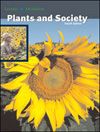 |  Plants and Society, 4/e Dr. Estelle Levetin,
University of Tulsa
Karen McMahon,
University of Tulsa
Diversity of Plant Life
Chapter Summary| 1. Currently biologists accept the Six-Kingdom System of classification. In this system, living organisms are classified as Archaebacteria, Eubacteria, Protista, Animalia, Plantae, and Fungi. Organisms traditionally known as plants are found in four of the six kingdoms.
2. The Kingdom Plantae contains land plants, which manufacture their own food through photosynthesis and retain a multicellular embryo within the female gametangium. All plants have an alternation of generations.
3. Some plants, such as mosses, hornworts, and liverworts, have a dominant gametophyte generation. These are small plants that are confined to moist environments since they have no vascular tissue.
4. All vascular plants have a dominant sporophyte. Four divisions of vascular plants do not form seeds. The ferns and fernallies have a long fossil history, and in past geological ages they dominated the landscape.
5. The seed plants are currently the dominant vegetation in the world. Four divisions of seed plants are gymnosperms. Conifers are the most familiar gymnosperms and include the largest, tallest, and oldest trees in the world. Conifers are of great economic importance as the source of wood, pulp, and chemicals. The angiosperms constitute the most widespread and diverse vegetation today. They provide most of the food for life on the planet as well as economically useful products. |
|



 2006 McGraw-Hill Higher Education
2006 McGraw-Hill Higher Education